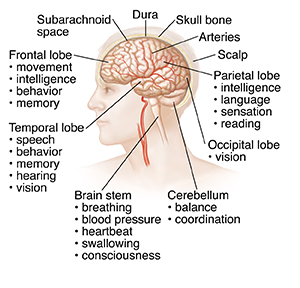A
B
C
D
E
F
G
H
I
J
K
L
M
N
O
P
Q
R
S
T
U
V
W
X
Y
Z
Topic IndexLibrary Index
Click a letter to see a list of conditions beginning with that letter.
Click 'Topic Index' to return to the index for the current topic.
Click 'Library Index' to return to the listing of all topics.
Understanding the Brain
The brain controls the entire body. The main areas of the brain include the cerebrum, cerebellum, forebrain, and brain stem. The cerebrum is divided into 2 halves that have 4 parts, called lobes. The 4 lobes are the frontal lobe, temporal lobe, parietal lobe, and occipital lobe. Different areas of the brain have different jobs. Some parts of the brain control basic things like breathing, blood pressure, and heartbeat. Other parts control more complex jobs, such as moving, thinking, speaking, the 5 senses, and memory.
 |
| Some body functions are controlled by just one part of the brain. Other functions are controlled by more than one part. |
Inside the skull
Under the scalp and the skull, a tough membrane (the dura) surrounds the brain. Beneath the dura, cerebrospinal fluid (CSF) cushions the brain and circulates in the subarachnoid space. Arteries carry oxygen-rich blood and nutrients throughout the brain. Without this blood, brain tissue quickly dies. The brain is made up of about 100 billion cells called neurons. These neurons allow the brain to do its many jobs.
Not pictured here is the forebrain. This part of the brain contains the thalamus, hypothalamus, and pituitary gland. The thalamus sends impulses from the sense organs to the cortex. The hypothalamus controls hunger, thirst, temperature, aggression, and sex drive. It also controls the pituitary gland, which controls the secretion of many hormones.
Online Medical Reviewer:
Jessica Gotwals RN BSN MPH
Date Last Reviewed:
4/1/2024
© 2000-2025 The StayWell Company, LLC. All rights reserved. This information is not intended as a substitute for professional medical care. Always follow your healthcare professional's instructions.